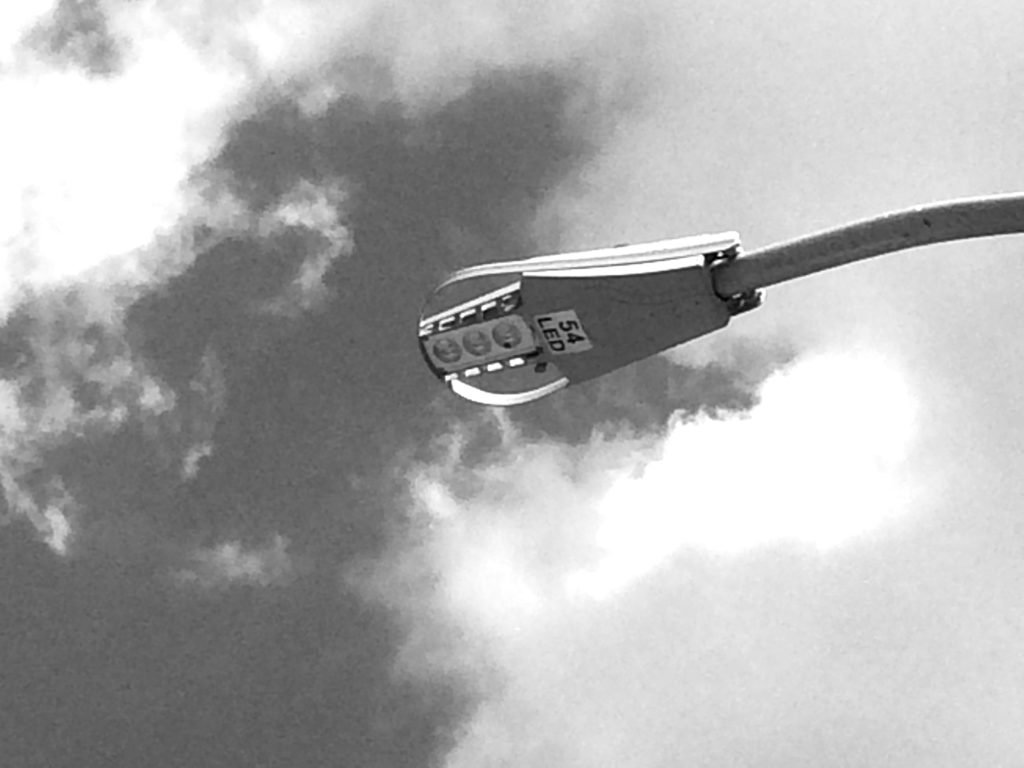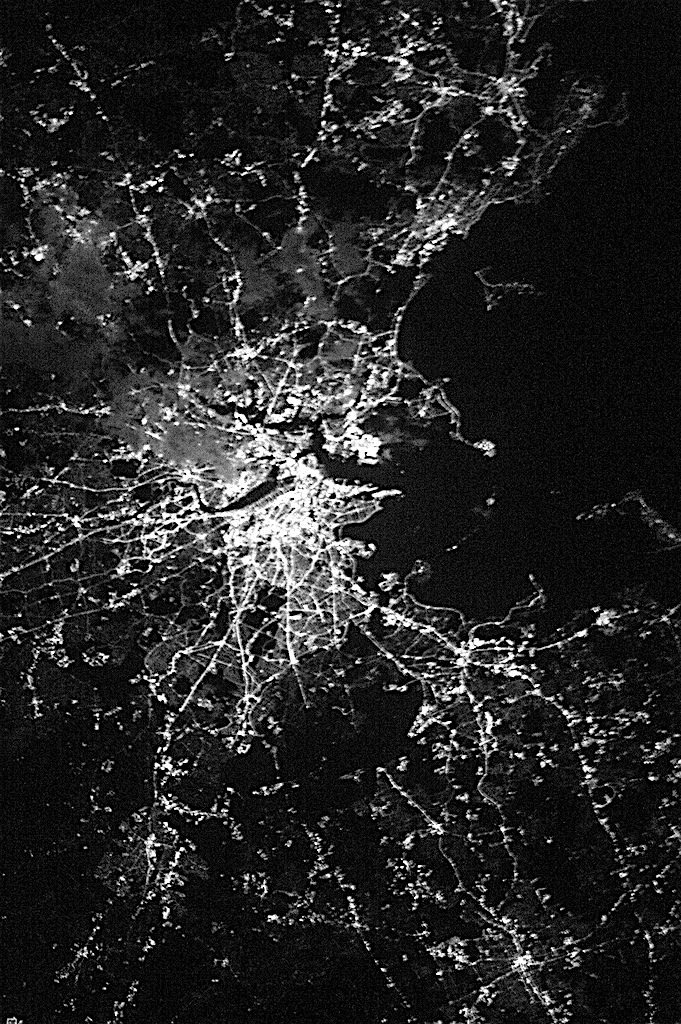Pilot Project Tests LED Streetlights
by Anne-Marie Lambert
Can you see me now?
The Belmont Light Department is working to improve the efficiency of our streetlights. A grant from the Massachusetts Department of Energy Resources funded the replacement of 100 of today’s 2,400 high-pressure sodium bulbs with LED (light-emitting diode) bulbs. This pilot project replaces 98 100-watt bulbs and two 250-watt bulbs with a variety of LED products.
The pilot project alone is expected to save 26 megawatt hours (MWh) per year, with a payback period of just over four years.
In the coming year, Belmont Light will evaluate the pilot installation for criteria including brightness, shadows, and intrusiveness in the neighborhoods where they are installed. (The town now has 2,392 streetlights.)
Greater Boston at night as seen from Space. Photo by NASA.
Lighting technology is changing rapidly at the same time that scientists are learning more about the impact of light on our sleep and on our health. LEDs are smarter and more efficient than old technologies but can also be much brighter. They particularly increase our exposure to blue light, which has negative effects. (More on that below).
On June 7, the Boston Area Sustainability Group (BASG) hosted a showing of The City Dark, a 2011 documentary about light pollution by filmmaker Ian Cheney. The film lamented the loss of places where stars in the night sky were visible and showed vivid images of migrating birds and turtles confused by light from buildings and streets. In recent decades, artificial light has masked the beauty of the night sky in more and more places. Belmont is part of the big bright light surrounding Boston in NASA’s 2012 composite image of the earth at night. (See nightearth.com.)
The City Dark
The documentary was followed by two brief presentations—one about the factors leading to dramatic increases in the amount of blue light to which we are exposed every day, and one about scientific research on the effects of different types of light on human health.
Jennifer Dolin of Osram Sylvania spoke about trends affecting today’s lighting industry. As the company’s manager of sustainability and environmental affairs, Dolin oversees issues including lamp and ballast recycling, greenhouse gas emissions reporting, and corporate responsibility initiatives.
She said the advent of solid-state lighting—programmable semiconductor devices that emit light—has brought dramatic changes such as ”intelligent” LED displays in sports stadiums and on vehicles.
An LED streetlight in front of Belmont High.
 By embedding tiny LEDs, there’s now also the potential to “print” lighting (or to weave lighting) into fabrics, carpets, and ceilings.
By embedding tiny LEDs, there’s now also the potential to “print” lighting (or to weave lighting) into fabrics, carpets, and ceilings.
. . . light of any kind can suppress the secretion of melatonin and . . . blue light does this more powerfully.
Dolin also discussed the advent of dark skies regulations to reduce light pollution. According to the New England Light Pollution Advisory Group, more than 40 communities in Massachusetts have instituted lighting ordinances since 2000. These typically require municipal and commercial outdoor lighting to have full cutoff fixtures and shields that direct light toward the ground. Arlington Town Meeting passed such an ordinance in 2014. The Cambridge Outdoor Lighting Task Force in 2014 recently recommended an outdoor lighting ordinance. It references standards issued by the Illuminating Engineering Society, the International Dark Sky Association, and the US Green Building Council. According to a 2014 Boston Globe article, Winstanley Enterprises took Chelmsford’s lighting rules a step further when building a mixed-use retail center. The Concord developer installed LED fixtures with a soft glow and lower color temperature that are easier on the eyes, cheaper, and more efficient than the rich blue lighting typically used.
. . . light of any kind can suppress the secretion of melatonin. . .
Dr. Eva Schernhammer of Harvard’s School of Public Health spoke at the BASG meeting about why light exposure matters to our health. Dr. Schernhammer’s major scientific contributions have addressed the effects of light at night on cancer risk through the melatonin pathway. Melatonin is a hormone that plays a key role in the control of our daily circadian rhythms.
Dr. Schernhammer’s work led to the establishment of a new classification of shift work as a probable human carcinogen by the World Health Organization in 2007. While her studies did not distinguish light exposure by color, light of any kind can suppress the secretion of melatonin, and it is known that blue light does this more powerfully, especially at night.
A 2012 Harvard Health Letter on blue light states, “Light at night is bad for your health, and exposure to blue light emitted by electronics and energy-efficient lightbulbs may be especially so.”
Updated in September 2015, the letter recommends avoiding looking at bright screens beginning two to three hours before bed, using dim red lights for night lights, and wearing blue-blocking glasses if working a night shift or using a lot of electronic devices at night.
Combined with exposing yourself to lots of bright light during the day, the letter said, avoiding blue light in the evening should “boost your ability to sleep at night, as well as your mood and alertness during daylight.”
Several technologies
I was glad to learn that Belmont Light is trying different LED technologies, and that brightness is a consideration in their assessment of the pilot. I hope they will also look at the color spectrum emitted by each product.
While the remaining streetlights are only 70 watts, the potential for energy savings from LED lights is significant. The town has installed smart electric meters that can collect usage and performance information about all streetlights.
I was glad to learn that Belmont Light is trying different LED technologies, and that brightness is a consideration in their assessment of the pilot.
Unlike Cambridge, Belmont has not invested in technologies that would allow us to dim streetlights late at night. We do, however, have lighting regulations which require businesses to turn off illuminated signs between the hours of 10 PM and 6 AM unless the premises on which they are located are open for business. Belmont also forbids any moving, flashing, or animated lights, or any automatically changing written or pictorial matter or message. Enforcement of these regulations currently relies mainly on citizen reports. According to GR 5.2.3(b), signs may be illuminated only by the following means:
1. By a white, steady stationary light shielded and directed solely at the sign;
2. By interior non-exposed lights;
3. By exposed neon or similar tube illumination.
It turns out that LED manufacturing does have some environmental challenges.
The presentations and a conversation with Becca Keane, energy resources analyst of Belmont Light, made me curious about identifying Belmont’s brightest and darkest places, and how our local and migrating wildlife were affected at night by bright lights on streets, at sports fields, on billboards, by the train tracks, and near large buildings like the new Acorn Park development now known as the Royal Belmont.
I also wondered about the lifecycle costs of LEDs and not just the operational efficiencies once they were manufactured.It turns out that LED manufacturing does have some environmental challenges. LEDs contain heavy metals such as lead, nickel, arsenic, and copper. Unlike CFLs (compact fluorescent lightbulbs), which contain mercury, LEDs are not classified as toxic: they can be disposed of in conventional landfills. LED bulbs come with hard and rubberized coatings to help keep them from shattering and releasing their contents, and should pose no health risks during regular use. But disposal and possible breakage are a consideration.
Less is more
From an energy conservation perspective, and from a public health point of view, less is more when it comes to lighting. The tradeoff seems to be with the public safety benefits of lighting up the night.
In addition, chemical plants involved in LED manufacturing in Massachusetts have suffered intense explosions when certain chemicals (e.g., trimethylaluminum) are exposed to water or air. In January a powerful explosion at a Dow chemical plant in North Andover critically injured four workers. Safety procedures are under review to reduce this risk.
From an energy conservation perspective, and from a public health point of view, less is more when it comes to lighting. The tradeoff seems to be with the public safety benefits of lighting up the night. The new streetlights in Belmont Center are shielded to ensure that all light faces down.
The City Dark included some wonderful images of clever lighting designs such as Manhattan’s High Line that uses downward-facing lights in the banisters. This leaves the night sky more visible for pedestrians to enjoy while still addressing public safety.
As Belmont Light evaluates the pilot, take a walk at night to find the darkest and lightest spots near your home. Let the Light Department know where you think we could get smarter with lighting—or not lighting—Belmont at night.
Anne-Marie Lambert is a director of the Belmont Citizens Forum.



Sorry, the comment form is closed at this time.